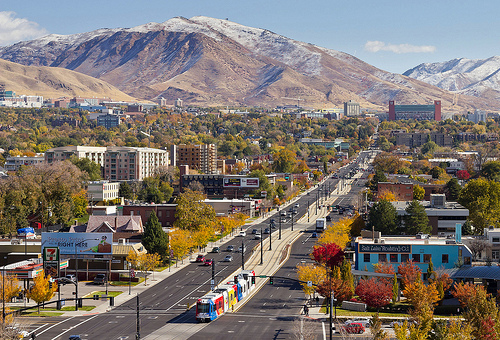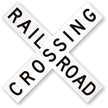Study: Salt Lake City light rail reduces traffic
A recent study has discovered that the light-rail system in Salt Lake City, Utah, reduces traffic, cuts costs and may improve the environment, reports the blog Planetizen. The study found that a light-rail line “reduces daily [traffic] from 44,000 (if it did not exist) to 22,300 (what actually occurs) on one arterial.”

Salt Lake City’s light rail system seems to be cutting down on traffic. From Photo Dean.
The study, Effect of Light-Rail Transit on Traffic in a Travel Corridor, was overseen by University of Utah researchers Reid Ewing, Guang Tian and Allison Spain and focused on the city’s light-rail system’s impact on vehicle traffic near the University of Utah. Known as TRAX, Salt Lake City’s light-rail system has served the city and surrounding suburbs since 2001. TRAX currently transports approximately 53,000 passengers daily on average.
The purpose of the study? “To quantify the effect of the University TRAX light-rail line on traffic near the University of Utah, providing quantitative data that can be used to shape future transportation policies aimed at reducing traffic congestion, energy consumption, air pollution, greenhouse gas emissions, and parking costs,” states the report.
“Our aim is to provide the first hard evidence of light rail’s impact on traffic in a travel corridor, to quantify the associated savings on energy consumption, air pollution, and parking costs, and to compare cost savings to transit subsidies.”
Earlier studies, run by the Utah Transit Authority using information gathered by the Utah Department of Transportation, revealed that university-area traffic has been reduced to a degree not witnessed since the 1980’s — despite the fact that the numbers of university students, faculty and staff numbers have grown. In fact, the university is Utah’s “second-largest traffic generator.”
Yet despite sizeable development in the studied area, the study discovered notable decreases in road traffic after the completion of the light-rail line. In fact, the study estimates that the light-rail line dropped daily vehicle traffic on the studied corridor by approximately 50% — from 44,000 vehicles, if the line didn’t exist, down to 22,300, which is the actual number of vehicles.
There are other significant findings. Analyzing related decreases in fuel consumption, air pollution, parking costs and traffic congestion, the study estimated that the light-rail system saves nearly 500,000 gallons of gasoline, saved the University nearly $24 million in avoided parking construction expenses, and prevents nearly 10 million pounds of CO2 emissions yearly.
The Salt Lake City study isn’t the first of its kind. A 2012 study focused on the light-rail system in Denver, Colorado also found that light-rail corridors reduce traffic on some highways, and that highway traffic increase is “noticeably lower within the influence zone of light rail.” An added bonus: A single electric light-rail train contributes almost 99 percent less carbon monoxide and hydrocarbon emissions than a single car does, per mile, according to the Federal Reserve Bank of St. Louis.
Light rail isn’t without critics. Detractors insist that light-rail systems can increase congestion, encourage urban sprawl, use up tax dollars, and connect the wrong neighborhoods.
Category: Infrastructure, Trends

















